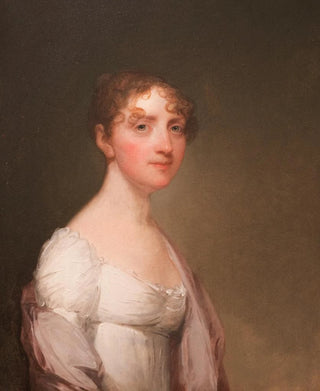Art print | Elizabeth Sproat Lenox 1785–1864 - Gilbert Stuart


View from behind

Frame (optional)
Elizabeth Sproat Lenox art print 1785–1864 - Gilbert Stuart – Captivating introduction
In the fascinating world of 18th-century American painting, the "Elizabeth Sproat Lenox" art print by Gilbert Stuart stands out for its emotional depth and striking realism. This depiction of a high society woman, both elegant and dignified, transports us to an era where art reflected social and cultural values. Through this art print, viewers are invited to rediscover not only the face of Elizabeth Sproat Lenox but also the essence of a time marked by profound social and political changes. The painting, with its finesse and delicacy, embodies a meeting between portraiture and female identity at the heart of a society in full transformation.
Style and uniqueness of the work
Gilbert Stuart's style is characterized by an exceptional mastery of portraiture, where every detail is carefully considered to capture the subject's individuality. In "Elizabeth Sproat Lenox," the chiaroscuro technique highlights the delicate features of his model, emphasizing the softness of her expression while revealing the complexity of her personality. The chosen colors, both rich and nuanced, create an intimate atmosphere that seems to invite the viewer into Elizabeth's private life. The way Stuart renders the textures of fabrics and hair demonstrates his skill in imitating reality while infusing an almost lifelike dimension into his subject. Each brushstroke appears to tell a story—a story of grace and strength, of a woman who, behind her serene appearance, bears the weight of her era.
The artist and his influence
Gilbert Stuart, born in 1755 in Rhode Island, is often regarded as one of the greatest portraitists of his time. His exceptional talent allowed him to create portraits of iconic figures in American history, including George Washington. Stuart successfully blended European influences with an American sensibility, creating a unique style that marked his era. His approach to portraiture goes beyond mere physical representation, seeking to capture the soul of his subjects. This quest for authenticity profoundly influenced subsequent generations of artists, establishing a standard for the

Matte finish

View from behind

Frame (optional)
Elizabeth Sproat Lenox art print 1785–1864 - Gilbert Stuart – Captivating introduction
In the fascinating world of 18th-century American painting, the "Elizabeth Sproat Lenox" art print by Gilbert Stuart stands out for its emotional depth and striking realism. This depiction of a high society woman, both elegant and dignified, transports us to an era where art reflected social and cultural values. Through this art print, viewers are invited to rediscover not only the face of Elizabeth Sproat Lenox but also the essence of a time marked by profound social and political changes. The painting, with its finesse and delicacy, embodies a meeting between portraiture and female identity at the heart of a society in full transformation.
Style and uniqueness of the work
Gilbert Stuart's style is characterized by an exceptional mastery of portraiture, where every detail is carefully considered to capture the subject's individuality. In "Elizabeth Sproat Lenox," the chiaroscuro technique highlights the delicate features of his model, emphasizing the softness of her expression while revealing the complexity of her personality. The chosen colors, both rich and nuanced, create an intimate atmosphere that seems to invite the viewer into Elizabeth's private life. The way Stuart renders the textures of fabrics and hair demonstrates his skill in imitating reality while infusing an almost lifelike dimension into his subject. Each brushstroke appears to tell a story—a story of grace and strength, of a woman who, behind her serene appearance, bears the weight of her era.
The artist and his influence
Gilbert Stuart, born in 1755 in Rhode Island, is often regarded as one of the greatest portraitists of his time. His exceptional talent allowed him to create portraits of iconic figures in American history, including George Washington. Stuart successfully blended European influences with an American sensibility, creating a unique style that marked his era. His approach to portraiture goes beyond mere physical representation, seeking to capture the soul of his subjects. This quest for authenticity profoundly influenced subsequent generations of artists, establishing a standard for the






